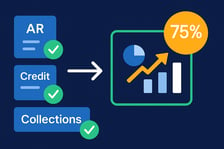A business line of credit offers flexible access to a predetermined amount of funds, allowing business owners to withdraw money as needed, much like using a bank account. However, since it functions like a loan, you’ll incur interest on any amount you borrow.
Unlike a term loan, which provides a lump sum upfront and requires fixed monthly payments with a set interest rate, a line of credit gives you more flexibility. It allows you to borrow and repay funds as needed, with interest only accruing on the amount you use. This makes it an excellent tool for managing cash flow, covering short-term expenses, or handling unexpected financial needs, all without locking you into a rigid repayment schedule.
The terms for repaying borrowed amounts can vary between lenders, but most agreements require that you pay at least the interest charges every month. If you choose to repay more than the minimum, you typically won't face penalties, unlike some term loans that impose fees for early repayment.
You can use the funds from your line of credit for virtually any legitimate business expense, from paying suppliers to covering advertising costs or even paying employees. Once approved, the funds remain available to you, though you're not required to use them. For example, if you have a $20,000 line of credit and have used $6,000, you still have $14,000 in available credit. If you repay the balance and interest charges, your access to the full $20,000 is restored. This flexibility is often referred to as revolving credit.
Small business owners have long used lines of credit to bridge the gap between making sales and receiving payments from customers. However, the challenges of recent years—such as the economic impact of the pandemic—have led many businesses to lean on their lines of credit to stay solvent during times of revenue decline due to lockdowns or restrictions. The ability to access funds without a fixed repayment schedule has been crucial for many businesses trying to weather unpredictable financial storms.
Beyond typical cash flow management, lines of credit can also serve as a financial buffer during times of growth. They allow businesses to scale quickly without the need for a large loan, providing quick access to capital to seize new opportunities or invest in necessary resources.
There are two primary types of lines of credit: secured and unsecured. A secured business line of credit requires collateral (such as inventory, real estate, or invoices) to secure the amount borrowed. If you default, the lender can seize the collateral to recover the funds. On the other hand, an unsecured business line of credit doesn’t require collateral but generally has stricter qualifying criteria. Both options offer flexibility, but understanding the trade-offs between security and requirements is essential for choosing the right option for your business.
Should I get a business credit card of business line of credit?
Great question! The two credit options have a few things in common:
- both charge you interest only on what you use/access
- both are revolving, meaning once you pay off the amount you borrowed/charged, you can access all the credit again
- both can help to improve your credit rating when you make consistent payments
- both are used by small businesses as a source of short term financing or to free up working capital
But there are a few differences. It’s generally easier to get approved for a business credit card, and you can qualify for a smaller credit limit—good if you’re a small business or just need a little financing and don't want a small business loan. However, credit cards typically charge much higher interest (from 14%-29%) than lines of credit (often beginning at 4.75%). And even if you get a low introductory rate for your credit card, it will increase over time. High interest rates on any type of credit for your business can cause a debt spiral that creates substantial financial challenges, even leading to bankruptcy.
If your business needs cash (for example, making payroll), you can take a cash withdrawal from your credit card. But credit cards almost always charge a higher interest rate for cash advances than for purchases so it might not be your best choice for business financing. Make sure you know what you’ll be charged and what your monthly payments will be if you carry a balance on your card. And while you may qualify for a business credit card linked to a rewards program, you'll likely pay an annual fee for the privilege—as well as an additional annual fee if you want more than one cardholder.
One of the reasons businesses may choose a credit card over a line of credit is a simpler and quicker application process. So, let’s look at the application process and requirements for a business line of credit.
Applying for a small business line of credit
Where you apply for a line of credit will have a lot to do with how complicated the process is. Applying at a traditional lender (for example, an established bank like Bank of America) often involves the most extensive application process, but the payoff is generally better terms (including fewer fees and lower interest rates) and a better submission to the credit bureau (it’s a good sign when a big bank approves your financing application). It can take a few weeks to be approved and receive access to your funds from a traditional lender. You may also receive a higher credit limit: banks approve lines of credit to businesses ranging on average from $5,000 to $200,000.
Most business line of credit requirements include providing at least two years of business financial statements, tax returns, balance sheets, and credit reports as well as your personal tax returns and credit history (again, for two years). If you’re in the startup phase, a few months of solid income statements may be accepted—especially if you have good personal credit.
Your lender may counter an application for an unsecured line of credit with a request for collateral so they can consider a secured business line of credit. This may happen when the amount you’re applying for exceeds a set amount, when your business doesn’t have a good financial history, or when your personal credit isn’t strong. Both your business credit score and your personal credit score play a role in what you're approved for, the value of collateral required, and how reasonable the terms are.
In this case, the collateral will be reviewed as part of the application process. If the collateral includes real estate or equipment, you’ll need to show proof of ownership and proof of the value of the collateral.
If the collateral is in the form of accounts receivable, the lender will likely investigate the companies owing you payments to verify the invoices are a good risk.
Applying through a major bank can also take longer for approval than using an online lender or a smaller bank/credit union. In every case, check the reliability of the lender and read all the small print carefully before deciding to proceed.
What about a business loan?
Business loans are an important financial product for many businesses. But they do vary a bit from a line of credit—both in what the funds are used for, and how the terms work.
A business loan is a set amount loaned for a specific purpose. It may be a startup loan, an SBA loan, an equipment loan, a general loan, or a commercial real estate loan. In every case, the lender will want details about what you are using the funds for.
Business loans will have set repayment terms—you pay the same every cycle until the loan is paid in full. Some business loans allow you to pay more than the fixed amount, which allows you to pay off the loan quicker (and save on interest charges) when business finances allow.
However, some business loans will either charge a penalty every time you pay more than the set amount, or won’t allow you to save on interest by paying out the loan early. In this case, if you wanted to pay off the loan early, you’d have to pay the full amount, including interest that would be charged over the initial terms of the loan.
With a line of credit, you don’t need to state in advance what the funds will be used for. Your only requirement is that they’re used for legitimate business activities. And, you can pay off the balance owing every month without penalties.
FAQs about business lines of credit
Are interest rates fixed on a business line of credit?
Yes… and no. The terms of each business line of credit can really vary depending on the lender, and your qualification criteria. It’s very important to read the fine print carefully before agreeing to the terms.
Rates may be fixed, variable, or fixed plus prime. In this case, your interest rate is always based on the current prime lending rate plus a fixed percentage. This is great when interest rates are low, but it’s good to be prepared for higher payments whenever the prime lending rate is increased.
Do I have to pay any extra fees?
Great question! Again, you’ll need to carefully check the terms to see what fees are included. Although it’s not a fee, your lender may have a clause that raises the interest rate if you’re late on a payment. Other fees can include an application fee and a maintenance fee (charged every month that you don’t use your line of credit). If there is an application fee, it doesn’t hurt to see if the lender will waive it.
Is there any other financing option that might be better for my business?
Yes. Thanks to technological advancements and financing companies who are really looking for the best options for their clients, you may be able to access something called credit-as-a-service. This service is available to new businesses, small businesses, and corporations.
Resolve Pay is one company that’s leading the way in this field. If you’re a B2B company with outstanding accounts receivable, you’re essentially acting as a bank—covering the cost of goods and services until your customer pays their invoice. Resolve eliminates this by covering the invoices for approved customers. You can receive up to 90% of each invoice paid into your account within 1 day—and Resolve still gives your customers 30, 60, or 90 day net terms.
If your business struggles with cash flow, you’re not alone. Use Resolve to quickly solve your cash flow problems and you may find you no longer need to seek other financing options. Speeding up cash flow will transform the financial health of your business.







